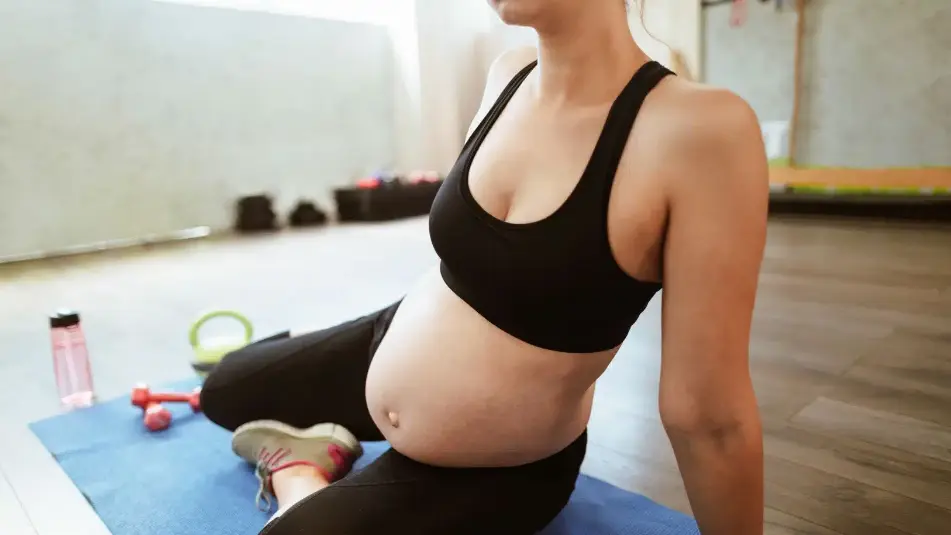Pregnancy is an excellent time in a woman’s life to adopt healthy lifestyle habits. In fact, Health Canada and the Society of Obstetricians and Gynaecologists of Canada (SOGC) recommend at least 150 minutes of moderate exercise per week, even for women who were previously sedentary.
Training and pregnancy
- Duration of training : for an active woman, it’s advisable to continue with her previous training volume, while respecting her feelings of fatigue during pregnancy. For a sedentary woman, we suggest starting with 15 minutes of physical activity 3 times a week and increasing to 45 minutes 5 times a week.
- Training intensity : the speech test is the best indicator of moderate-intensity training. It consists of trying to hold a conversation during training. If the breathlessness is too intense to do so, the workout is also too intense.
- Type of training : A combination of activities is recommended, including cardiovascular exercise (brisk walking, cycling, swimming), strength training and body awareness exercises (yoga, Pilates).
- Pelvic floor muscles: Pelvic floor exercises aim to prevent urinary (e.g. incontinence) and gynaecological (e.g. organ descent) disorders associated with pregnancy and childbirth. The practice also helps minimize pregnancy-related musculoskeletal pain (back, sciatica, symphysis pubis, coccyx).
Posture… often forgotten!
It’s also essential to pay particular attention to postural habits, i.e. positioning outside exercise periods. It’s also a good way for busy moms to hide reinforcement in their day.
- Sitting posture : Make sure you have ergonomic workstations and stand up (go from sitting to standing) every 15 minutes. For an 8-hour shift, that’s 32 squats!
- Standing posture : Weight should be distributed evenly on both feet, taking care not to wiggle (putting more weight on one leg than the other). If you have a toddler, try to prioritize taking him in a seated position.
Exercises not recommended during pregnancy
Classic crunch-style sit-ups should be avoided during pregnancy. It’s better to opt for total-body exercises, which focus on the transversus abdominis and pelvic floor muscles.
High-intensity team sports and/or those predisposing to falls or blows to the stomach, such as basketball, field hockey, soccer and tennis, are also not recommended. Added to this list are individual sports that involve the risk of falls, such as gymnastics, scuba diving, high-altitude activities, downhill skiing, skating and mountain biking.
Relative contraindications to exercise during pregnancy
Some health conditions require further evaluation by a health professional before recommending safe exercise.
These include :
- Recurrent spontaneous abortions
- History of premature birth
- Gestational hypertension
- Symptomatic anemia
- Malnutrition or eating disorders
- Twin pregnancy (twins), after the 28th week
Absolute contraindications to exercise during pregnancy
Other more serious conditions present absolute contraindications to exercise. This is to prevent complications for the baby.
These include :
- Rupture of membranes
- Premature labor
- Vaginal bleeding
- Placenta previa, after 28 weeks of pregnancy
- Preeclampsia
- Cervical insufficiency
- Multiple pregnancy (triplets and more)
- Growth retardation
- Uncontrolled diabetes, hypertension or thyroid disease
- Severe cardiac or respiratory disorder
- Other major health problems
To find out more about contraindications and precautions to physical activity during pregnancy, you can take the test by completing the following questionnaire : Get active questionnaire for pregnancy.
Physical activity is an excellent way of adapting to all the changes taking place during pregnancy and keeping your body strong and full of energy. Postural adaptations, right from the start of pregnancy, help you to live in comfort. Don’t hesitate to consult a physiotherapist trained in pelvic-perineal rehabilitation for guidance.
Written in partnership with Sophie Villeneuve,
Physiotherapist and expert in pelvic-perineal rehabilitation
Book an appointment
Updated article : March, 2025.
Watch these videos:
- The Pelvic Floor (in french)
- Aqua-form and Pregnancy (in french)
- Massages for Pregnant Women (in french)
References :
-
SOGC https://sogc.org/fr/fr/content/featured-news/nouvelle-directve-prescrit-lactivite-physique-pour-favoriser-la-sante-des-femmes-enceintes.aspx
-
DIRECTIVE CLINIQUE CONJOINTE DE LA SOGC ET DE LA SCPE, Les directives Canadiennes en matière d’activité physique pendant la grossesse, N° 367, novembre 2018
-
Société canadienne de physiologie de l’exercice (SCPE), Édition 2019 des Directives canadiennes en matière d’activité physique pendant la grossesse.
-
INSPQ https://www.inspq.qc.ca/mieux-vivre/grossesse/quotidien-pendant-grossesse/activites-physiques
-
Gouvernement du Canada https://www.canada.ca/fr/sante-publique/services/promotion-sante/grossesse-sante/guide-grossesse-sante.html#a7


